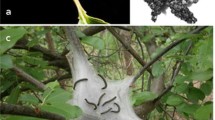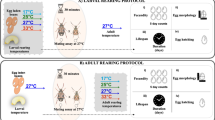Abstract
Climate change is disrupting species interactions by altering the timing of phenological events such as budburst for plants and hatching for insects. We combined field observations with laboratory manipulations to investigate the consequences of climate warming on the phenology and performance of the eastern tent caterpillar (Malacosoma americanum). We evaluated the effects of warmer winter and spring regimes on caterpillar hatching patterns and starvation endurance, traits likely to be under selection in populations experiencing phenological asynchrony, using individuals from two different populations (Washington, DC, and Roswell, GA). We also quantified the proximate and extended fitness effects of early food deprivation and recorded spring phenology of local caterpillars and their host plants. In addition, we conducted laboratory assays to determine if caterpillars are using plant chemical cues to fine-tune their hatching times. Warmer winter temperatures induced earlier hatching and caterpillars from GA survived starvation for periods that were 30 % longer than caterpillars from DC. Warmer spring regimes reduced the starvation endurance of caterpillars overwintering in the wild but not in the laboratory. Early starvation dramatically reduced hatchling survival; however, surviving caterpillars did not show detrimental effects on pupal mass or development time. In the field, hatching preceded budburst in both 2013 and 2014 and the period of optimal foliage quality was 2 weeks shorter in 2013. Hatching time was unaffected by exposure to plant volatiles. Overall, we found that warmer temperatures can trigger late-season asynchrony by accelerating plant phenology and caterpillars from different populations exhibit differential abilities to cope with environmental unreliability.







Similar content being viewed by others
References
Arnett AE, Gotelli NJ (2003) Bergmann’s rule in larval ant lions: testing the starvation resistance hypothesis. Ecol Entomol 28:645–650
Ausín I, Alonso-Blanco C, Martínez-Zapater M (2005) Environmental regulation of flowering. Int J Dev Biol 49:689–705. doi:10.1387/ijdb.052022ia
Bale JS, Masters GJ, Hodkinson ID et al (2002) Herbivory in global climate change research: direct effects of rising temperature on insect herbivores. Glob Change Biol 8:1–16
Battisti A, Stastny M, Netherer S et al (2005) Expansion of geographic range in the pine processionary moth caused by increased winter temperatures. Ecol Appl 15:2084–2096. doi:10.1890/04-1903
Berggren Å, Björkman C, Bylund H, Ayres MP (2009) The distribution and abundance of animal populations in a climate of uncertainty. Oikos 118:1121–1126. doi:10.1111/j.1600-0706.2009.17558.x
Bradshaw WE, Zani PA, Holzapfel CM (2004) Adaptation to temperate climates. Evolution 58:1748–1762
Brower LP, Williams EH, Slayback DA et al (2009) Oyamel fir forest trunks provide thermal advantages for overwintering monarch butterflies in Mexico. Insect Conserv Divers 2:163–175. doi:10.1111/j.1752-4598.2009.00052.x
Buse A, Good JEG (1996) Synchronization of larval emergence in winter moth (Operoptera brumata L.) and bud burst pedunculate oak (Quercus robur L.) under simulated climate change. Ecol Entomol 21:335–343
Butt CD, Quiring C, Hébert J, Delisle R, Berthiaume E, Bauce Royer L (2010) Influence of balsam fir (Abies balsamea) budburst phenology on hemlock looper (Lambdina fiscellaria). Entomol Exp Appl 134:220–226
Conover DO, Schultz ET (1995) Phenotypic similarity and the evolutionary significance of countergradient variation. Trends Ecol Evol 10:248–252
Dukes JS, Pontius J, Orwig D, Garnas JR, Rodgers VL, Brazee N, Cooke B, Theoharides KA, Stange EE, Harrington R, Ehrenfeld J, Gurevitch J, Lerdau M, Stinson K, Wick R, Ayres M (2009) Responses of insect pests, pathogens, and invasive plant species to climate change in the forests of northeastern North America: what can we predict? Can J For Res 39:231–248
Ellwood ER, Temple AS, Primack RB, Bradley NL, Davis CC (2013) Record-breaking early flowering in the eastern United States. PLoS ONE 8:e53788
Feeny P (1970) Seasonal changes in oak leaf tannins and nutrients as a cause of spring feeding by winter moth caterpillars. Ecology 51:565–581
Fitzgerald TD (1995) The tent caterpillars, 1st edn. Cornell University Press, Ithaca
Forkner RE, Marquis RJ, Lill JT, Le Corff J (2008) Timing is everything? Phenological synchrony and population variability in leaf-chewing herbivores of Quercus. Ecol Entomol 33:276–285
Forrest J, Miller-Rushing AJ (2010) Toward a synthetic understanding of the role of phenology in ecology and evolution. Philos Trans R Soc Lond B 365:3101–3112. doi:10.1098/rstb.2010.0145
Forrest J, Inouye DW, Thomson JD (2010) Flowering phenology in subalpine meadows: does climate variation influence community co-flowering patterns? Ecology 91:431–440
Gordo O, Sanz JJ (2005) Phenology and climate change: a long-term study in a Mediterranean locality. Oecologia 146:484–495
Gordo O, Sanz JJ (2006) Climate change and bird phenology: a long-term study in the Iberian Peninsula. Glob Change Biol 12:1993–2004
Gwinner E (1996) Circadian and circannual programmes in avian migration. J Exp Biol 119:3948
Hothorn TK, Hornik MA, van de Wiel Zeileis A (2006) A lego system for conditional inference. Am Stat 60:257–263
Hunter MD (1990) Differential susceptibility to variable plant phenology and its role in competition between two insect herbivores on oak. Ecol Entomol 15:401–408
IPCC (2014) Climate change 2014: impacts, adaptation, and vulnerability. Part B: regional aspects. In: Barros VR, Field CB, Dokken DJ, Mastrandrea MD, Mach KJ, Bilir TE, Chatterjee M, Ebi KL, Estrada YO, Genova RC, Girma B, Kissel ES, Levy AN, MacCracken S, Mastrandrea PR, White LL (eds) Contribution of working group II to the fifth assessment report of the intergovernmental panel on climate change. Cambridge University Press, Cambridge
Irwin JT, Lee RE Jr (2003) Cold winter microenvironments conserve energy and improve overwintering survival and potential fecundity of the goldenrod gall fly, Eurosta solidaginis. Oikos 100:71–78. doi:10.1034/j.1600-0706.2003.11738.x
Ivashov AV, Boyko GE, Simchuk P (2002) The role of host plant phenology in the development of the oak leafroller moth, Tortrix viridana L. Lepidoptera: Tortricidae). For Ecol Manag 157:7–14
Jamieson MA, Schwartzberg EG, Raffa KF et al (2014) Experimental climate warming alters aspen and birch phytochemistry and performance traits for an outbreak insect herbivore. Glob Change Biol doi:10.1111/gcb.12842
Kharouba HM, Vellend M, Sarfraz RM, Myers JH (2015) The effects of experimental warming on the timing of a plant-insect herbivore interaction. J Anim Ecol. doi:10.1111/1365-2656.12328
Klapwijk MJ, Ayres MP, Battisti A, Larsson S (2012) Assesing the impact of climate change in outbreak potential. In: Barbosa P, Letourneau DK, Agrawal A (eds) Insect outbreaks revisited. Blackwell, West Sussex, pp 429–450
Košťál V (1992) Orientation behavior of newly hatched larvae of the cabbage maggot, Delia radicum (L.) (Diptera: Anthomyiidae), to volatile plant metabolites. J Insect Behav 5:61–70
Laube JT, Sparks H, Estrella N, Höfler J, Ankerst DP, Menzel A (2014) Chilling outweighs photoperiod in preventing precocious spring development. Glob Change Biol 20:170–182
Leinonen I, Hänninen H (2002) Adaptation of the timing of bud burst of Norway spruce to temperate and boreal climates. Silva Fenn 36:695–701
Miller-Rushing AJ, Primack RB (2008) Global warming and flowering times in Thoreau’s Concord. Ecology 89:332–341
Neal JW, Chittams JL, Bentz JA (1997) Spring emergence by larvae of the eastern tent caterpillar a hedge against high risk conditions. Ann Entomol Soc Am 90:596–603
Parmesan C (2007) Influences of species, latitudes and methodologies on estimates of phenological response to global warming. Glob Change Biol 13:1860–1872
Parmesan C, Yohe G (2003) A globally coherent fingerprint of climate change impacts across natural systems. Nature 421:37–42
Primack RB, Higuchi H, Miller-Rushing AJ (2009) The impact of climate change on cherry trees and other species in Japan. Biol Conserv 142:1943–1949. doi:10.1016/j.biocon.2009.03.016
R Core Team (2013) R: a language and environment for statistical computing. R Foundation for Statistical Computing, Vienna
Rodenhouse NL, Christenson LM, Parry D, Green LE (2009) Climate change effects on native fauna of Northeastern forests. Can J For Res 39:249–263
Sarfraz RM, Kharouba HM, Myers JH (2013) Tent caterpillars are robust to variation in leaf phenology and quality in two thermal environments. Bull Entomol Res 103:522–529
Schwartz MD, Ault TR, Betancourt JL (2013) Spring onset variations and trends in the continental United States: past and regional assessment using temperature-based indices. Int J Climatol 33:2917–2922
Schwartzberg EG, Jamieson MA, Raffa KF, Reich PB, Montgomery RA, Lindroth RL (2014) Simulated climate warming alters phenological synchrony between an outbreak insect herbivore and host trees. Oecologia 175:1041–1049
Singer MC, Parmesan C (2010) Phenological asynchrony between herbivorous insects and their hosts: signal of climate change or pre-existing adaptive strategy? Philos Trans R Soc Lond B 365:3161–3176
Stenseth NC, Mysterud A (2002) Climate, changing phenology, and other life history traits: nonlinearity and match-mismatch to the environment. Proc Natl Acad Sci USA 99:13379–13381. doi:10.1073/pnas.212519399
Stockhoff BA, Url S (1991) Starvation resistance of gypsy moth, Lymantria dispar (L.) (Lepidoptera : Lymantriidae): tradeoffs among growth, body size, and survival. Oecologia 88:422–429
Stuhldreher G, Hermann G, Fartmann T (2014) Cold-adapted species in a warming world—an explorative study on the impact of high winter temperatures on a continental butterfly. Entomol Exp Appl 151:270–279. doi:10.1111/eea.12193
Tauber MJ, Tauber CA, Masaki S (1986) Seasonal adaptations of insects. Oxford University Press, New York
Van Asch M, Visser ME (2007) Phenology of forest caterpillars and their host trees: the importance of synchrony. Annu Rev Entomol 52:37–55
Visser ME, Both C (2005) Shifts in phenology due to global climate change: the need for a yardstick. Proc R Soc Lond B 272:2561–2569
Visser ME, Holleman LJ (2001) Warmer springs disrupt the synchrony of oak and winter moth phenology. Proc R Soc Lond B 268:289–294
Voigt W, Perner J, Davies AJ et al (2003) Trophic levels are differentially sensitive to climate. Ecology 84:2444–2453
Vries HH, Ens SH, Graaf G et al (2011) Synchronization of egg hatching of brown hairstreak (Thecla betulae) and budburst of blackthorn (Prunus spinosa) in a warmer future. J Insect Conserv 15:311–319
Vuorinen T, Nerg AM, Vapaavuori E, Holopainen JK (2005) Emission of volatile organic compounds from two silver birch (Betula pendula Roth) clones grown under ambient and elevated CO2 and different O3 concentrations. Atmos Environ 39:1185–1197
Wagenhoff E, Blum R, Engel K, Veit H, Delb H (2013) Temporal synchrony of Thaumetopoea processionea egg hatch and Quercus robur budburst. J Pest Sci 86:193–202
Walther GR, Post E, Convey P et al (2002) Ecological responses to recent climate change. Nature 416:389–395
Weed AS, Ayres MP, Hicke JA (2013) Consequences of climate change for biotic disturbances in North American forests. Ecol Monogr 83:441–470
Witzgall P, Ansebo L, Zhihua Y, Angeli G, Sauphanor B, Bengtsson M (2005) Plant volatiles affect oviposition by codling moths. Chemoecology 15(77):83
Yang LH (2012) The ecological consequences of insect outbreaks. In: Barbosa P, Letourneau DK, Agrawal A (eds) Insect outbreaks revisited. Blackwell Publishing Ltd, West Sussex, pp 197–218
Yang LH, Rudolf VHW (2010) Phenology, ontogeny and the effects of climate change on the timing of species interactions. Ecol Lett 13:1–10
Acknowledgments
Funding was generously provided by the Washington Biologist’s Field Club, The Harlan Trust Fund, a PhD fellowship from CONACyT (Mexico) and a George Melendez Wright Climate Change Fellowship, National Park Service (USA) to MA. We thank, E. Sigmon, A. Ashwati, M. Sliwinski, C. Indech and E. Bethke for their research assistance and S. Powell and two anonymous reviewers for comments on a previous version of this manuscript. All experiments were performed in compliance with the laws of the United States.
Author information
Authors and Affiliations
Corresponding author
Additional information
Communicated by Julia Koricheva.
Rights and permissions
About this article
Cite this article
Abarca, M., Lill, J.T. Warming affects hatching time and early season survival of eastern tent caterpillars. Oecologia 179, 901–912 (2015). https://doi.org/10.1007/s00442-015-3371-x
Received:
Accepted:
Published:
Issue Date:
DOI: https://doi.org/10.1007/s00442-015-3371-x




